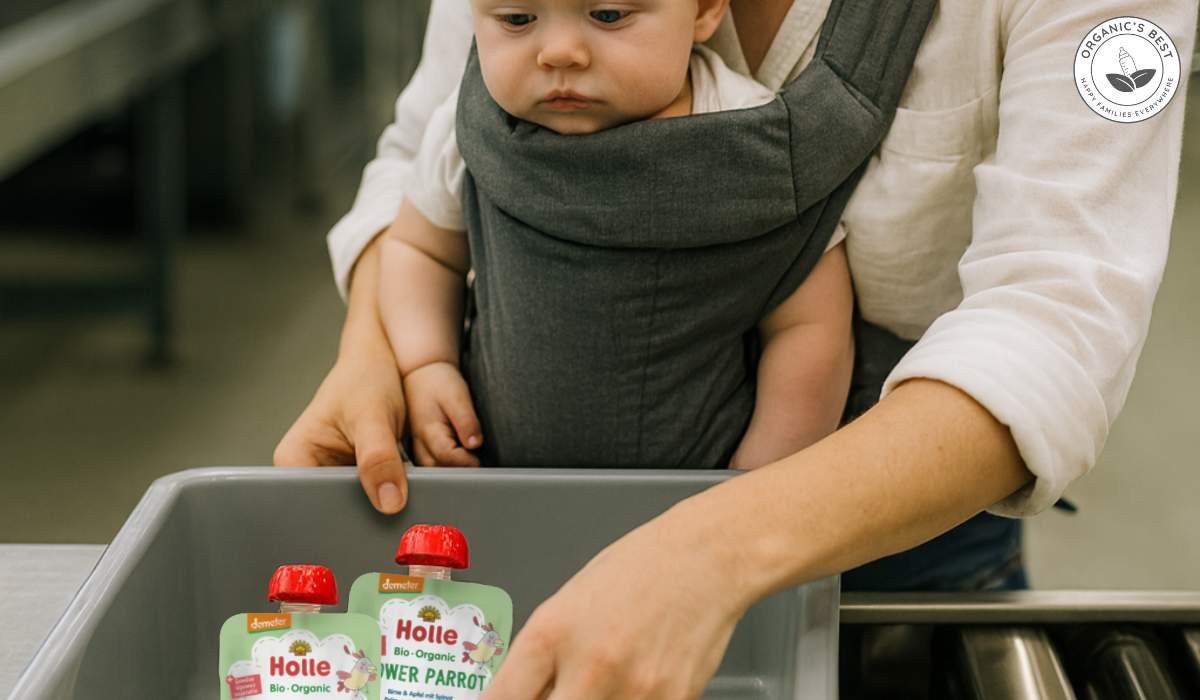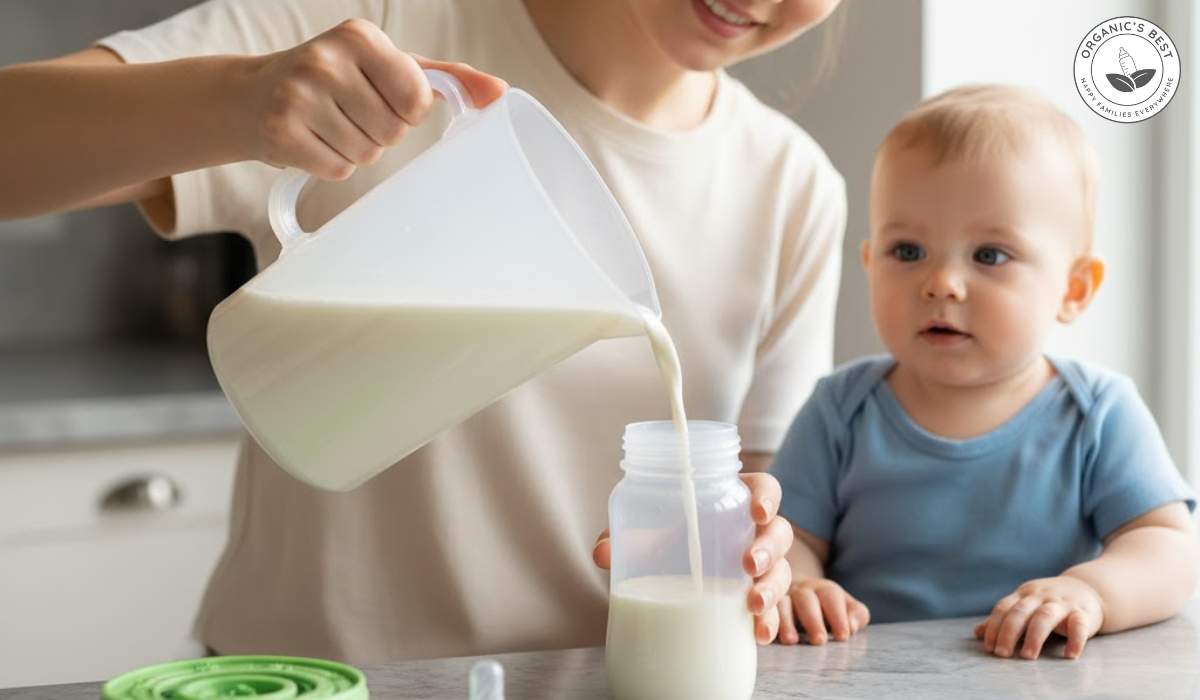Click to Get 2 FREE Boxes/Cans
Only New Customers! Click HERE to Get 2 Extra Boxes/Cans for Free With Your First Order.
BABY FORMULA
Offering new parents top-quality European infant formula from renowned brands like HiPP, Holle, Kendamil, and more. If you’re uncertain about which product to choose, our Formula Finder can help you make the best decision for your baby.
Baby Food
Offering new parents a premium selection of European baby foods, including jars, pouches, cereals, and snacks from esteemed brands like HiPP and Holle.
How to Wean off Pumping: Weaning Tips for Moms
by Agustina Fernandez October 01, 2024 8 min read

Your body undergoes remarkable changes before, during, and after childbirth, and choosing to wean off pumping is yet another important transition in your motherhood journey.
It is also a significant step for your tiny tot as they continue to grow and develop, relying more on formula or solid foods, depending on their age and feeding needs.
A weaning journey can look a little different for everyone, depending on how long you've been pumping, how often you were pumping, and whether you are exclusively pumping or supplementing with other feeding methods.
However, one thing is for certain: creating a plan that considers your physical comfort and emotional well-being can help ensure a smooth transition for mom and baby. It's important to approach this process carefully, gradually reducing pumping sessions while tuning into your body and your baby's needs.
Above all else, we want to prioritize a gradual transition, as cutting it cold turkey could lead to complications for mothers like engorgement, blocked ducts, or mastitis. Plus, an abrupt stop to pumping can also shock your baby's digestive and immune systems.
Join us as we walk through the reasons moms may decide to stop pumping, how to wean from pumping emotionally and physically, and practical tips to avoid complications throughout this transition. If you’re feeling uncertain, remember that lactation consultants, pediatricians, and other healthcare professionals can offer personalized advice!
Table of Contents
Common Reasons for Weaning from Pumping
The choice to stop pumping can arise for several reasons. For some, it comes as a natural part of their breastfeeding journey; for others, changes to their health or life circumstances may be the culprit.
There is no one-size-fits-all timeline for your baby's feeding journey, so some mothers start this process sooner than others.
Here are some of the most common reasons mothers stop pumping.

Heading Back to Work: This reason frequently arises as parents transition from the newborn nesting period. Since workplaces may be unable to accommodate the time and/or space for pumping, a mother's return to work may signal a transition away from pumping.
Low Milk Supply: A low milk supply can happen for several reasons, including health-related ones, like taking certain medications, conditions like anemia, or high stress. While your milk supply will naturally dry up when you reduce pumping, if maintaining it becomes difficult for other reasons, it may be time to stop breast pumping.
Sore Nipples: While a certain level of soreness is common for most mothers, if this pain becomes hard to manage and is significantly impacting your life, it may be time to step away from the breast pump. This is especially relevant if you've experienced clogged ducts or engorgement.
Pregnancy: If you become pregnant while breastfeeding, you may notice some extra discomfort or changes to your milk supply, making pumping impractical during this period.
Declined interest from Baby: Once babies can experiment with solid foods, they may gradually begin to wean themselves. This is a natural step in their feeding journey, reducing the need for as much breast milk and, therefore, less pumping.
Preparing Stopping Pumping: Physical and Emotional Impacts
It is important to consider how weaning from pumping may affect you both physically and emotionally. Due to hormonal shifts, it's natural for mothers to build emotional ties to breastfeeding and feel impacted by their baby's response to this change.
Allow yourself to wean at a pace that suits you and your baby best while paying close attention to your mind and your body during this time.
Your body will need time to adjust physically to producing less milk, but emotionally adapting can be a bit more complicated.
If you're seeking reassurance during this transition, start by tuning into your body's needs and observing whether your baby is showing signs of readiness to move away from breast milk. The decision to stop pumping often stems from one of two things: either it's a natural progression as your baby's feeding habits evolve or your body signaling that it's time to take the next step in your journey as a mother. Remember that breast milk production follows a supply-and-demand pattern.
Secondly, it is completely normal for the end of pumping to trigger a range of emotions. Many mothers feel a sense of loss as they navigate their bond with their baby post-breastfeeding. On the other hand, some mothers also feel relief because, let's face it, breast pumping can take a toll on your body and mind.

Maintaining your milk supply, finding the right feeding rhythm with your baby, and managing any pain or discomfort associated with pumping can be challenging. So, if you're feeling a sense of loss or relief, let yourself feel it.
Finally, remember that you are not alone in this. Mothers worldwide are familiar with this transition and have gone through exactly what you're going through.
Take this time to talk with your partner, friends, or lactation consultants about your decision, and seek support if you need it to process the emotional changes.
When it doubt, your pediatrician can also answer any questions that you may have about your baby's diet and feeding journey.
How to Stop Pumping: Weaning Pumping Schedule
The best way to stop pumping is gradually. This helps prevent discomfort and maintain your milk supply at a pace your body can handle and one that your baby can adjust to. In this case, slow and steady wins the race.
If you're following a weaning-off pumping schedule, it could resemble any of the following methods:

-
Dropping Pumping Sessions: Start by eliminating one pumping session at a time. If you're pumping five times a day, drop to four for a few days. Once your body adjusts, reduce to three, and so on.
-
Increasing Time Between Pumping Sessions: Another method is to extend intervals between pumping sessions. For instance, if you're pumping every four hours, increase that to five for a few days, then six or seven hours. This gradually signals your body to produce less milk.
-
Shortening Pumping Duration: If you're not ready to eliminate a session, reduce the time you spend pumping during each session. If you usually pump for 20 minutes, cut down to 15, then 10 minutes.
How to Stop Pumping without Getting Mastitis or Clogged Ducts
One of the reasons that mothers decide to stop pumping breast milk is due to discomfort-so it makes sense that we want to avoid discomfort during this transition.
If you wean from the breast pump too quickly, it can result in uncomfortable or even dangerous complications.
If milk isn't expressed regularly, mastitis, a breast infection, or clogged milk ducts can occur. So, give your body time to adapt and naturally reduce your milk supply.
If you experience flu-like symptoms, fever, or severe breast pain, consult your healthcare provider immediately. Mastitis often requires antibiotics and rest. Otherwise, follow these tips to avoid discomfort:
-
Avoid Cold Turkey: Abruptly stopping pumping is not recommended. This sudden change can lead to engorgement, mastitis, or clogged ducts, which are painful and can disrupt your breastfeeding journey.
-
Gradually Decrease Frequency and Duration: By slowly reducing the frequency of pumping sessions and the amount of time you pump, you give your body the signal to gradually reduce milk production.
-
Watch for Signs of Blocked Ducts: Pay close attention to any lumps, tenderness, or redness in your breasts. These could be signs of a blocked duct. If you notice a persistent lump or any pain, contact your healthcare provider to prevent an infection.
-
Use Warm Compresses: Warm compresses before a pumping session or cold packs afterward can soothe discomfort and help prevent blocked ducts. Massage your breasts during pumping sessions to keep milk flowing freely.
-
Check Your Bra: Make sure your bra isn't too tight. Tight clothing can compress the milk ducts and contribute to blockages. Choose comfortable, supportive bras that allow for gentle breast movement.
Self-Care Tips After Weaning off Pumping

You deserve to pour the same love into your body that you give to your baby, especially during periods of big change. Taking the time to refuel with self-care can make a huge difference in how you show up for yourself and your family.
Finding quiet moments to prioritize self-care while your baby is napping is helpful, but don't be afraid to also lean on your support system.
On a day-to-day basis, focus on staying hydrated and eating a balanced diet (we know it is easier said than done). This can feel impossible, but creating time for rest and relaxation can be a huge help. The weaning process can be physically and emotionally tiring, and your body needs some time to adjust and recover from its time nourishing your little one.
Once you feel up to it, exercise can also be a great way to help lift your mood, reduce stress, and support your body as it transitions away from milk production. Even getting some fresh air on a gentle walk can make a huge difference.
Finally, staying on top of your breast health can ease your body and mind. During and after this transition, continue to check your breasts for any signs of lumps, redness, or tenderness. If anything feels unusual, consult with your healthcare provider.
Answering Your Questions on Wean off Pumping
Here are some commonly asked questions parents have about how to wean off pumping and baby weaning.
How Long Does it Take to Wean off Pumping?
There is no perfect timeline for weaning off of pumping. Factors such as milk supply, pumping frequency, and your baby's readiness to transition to other nutrition sources play a role. On average, it may take several weeks to a few months to fully wean off pumping. The most important thing is to go at your own pace and listen to your body and remember that every mother and baby is unique.
How to Know When to Stop Pumping
You may notice signs from your own body, behaviours from your baby that signal it is time to stop pumping, or life circumstances may sway your decision. Returning to work, starting your baby on solid foods, having a low milk supply, or nipple pain are all valid reasons to start a schedule to wean off pumping. If you're unsure, consult a healthcare professional to make the right decision for you and your baby.
How Can I Make the Switch from Pumping to Formula?
A gradual transition is best, so begin by replacing one pumping session with a formula feeding. Over time, increase the number of formula feedings so that your baby can adjust to the change. This allows your baby's digestive system to adapt smoothly and helps your body naturally reduce milk production.
|
Disclaimer:
Please be aware that this information is based on general trends in babies, and it is not medical advice. Your doctor should be your first source of information and advice when considering any changes to your child’s formula and when choosing your child’s formula. Always consult your pediatrician before making any decisions about your child’s diet or if you notice any changes in your child. Breastfeeding is the best nutrition for your baby because breast milk provides your child with all the essential nutrients they need for growth and development. Please consult your pediatrician if your child requires supplemental feeding. |
Agustina Fernandez
Dr. Agustina Fernandez earned her medical degree from the prestigious Universidad Nacional de Córdoba, Argentina. With a deep-rooted passion for pediatrics, Dr. Fernandez is currently on the path to specializing in children's healthcare. Recently, she has delved into the vital field of infant nutrition. Her research interests include breastfeeding, infant formula, and baby food in little ones’ formative years. Dr. Fernandez's commitment to this area of study underscores her dedication to ensuring the health and well-being of children from their earliest days.
Leave a comment
Comments will be approved before showing up.
Also in Organic Infant Nutrition and Health Blog

Everything You Need To Know About Winter Pregnancy: Essential Tips for Moms-to-be
by Agustina Fernandez December 16, 2025 8 min read
Read More
Can You Bring Baby Food Pouches on a Plane? Essential Tips for Parents
by Agustina Fernandez December 09, 2025 7 min read
Read More
The Formula Pitcher: Is It Safe To Make A Whole Pitcher Of Baby Formula?
by Agustina Fernandez December 02, 2025 8 min read
Read More
Reviewed by Dr. Bardha Citaku, MD
-

Dr. Bardha Citaku: Medical Reviewer of Organic's Best Blog
Dr. Bardha Citaku completed her medical studies at the University of Prishtina in Kosovo, where she began her journey into the field of medicine. She has since developed a career in medical research, contributing to projects with notable organizations, including the World Health Organization (WHO).
